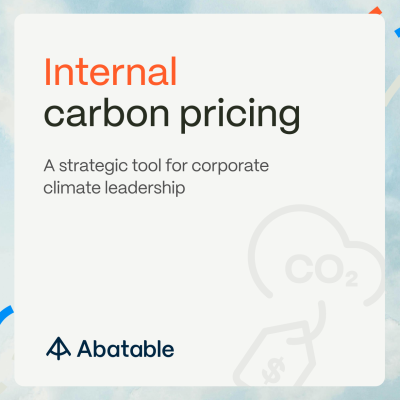Investment managers around the world are increasingly waking up to climate change. From the decarbonisation toolkit, investment managers are eyeing a new concept – ‘carbon neutral’ funds. But what does a carbon-neutral fund look like, and what does this mean for investors?
First, let’s unpack the term ‘carbon neutral’.
Many human activities, such as industrial processes, transportation, and energy production, produce GHG emissions, which are being measured in CO2 equivalents for the activity in question. To make an activity ‘carbon neutral’ its emissions must be firstly reduced, and for what is hard-to-abate, balanced (or ‘offset’) by taking an identical amount of equivalent CO2 emissions out of the atmosphere in another measurable way. Theoretically, this results in both a carbon reduction, as well as compensation or neutralisation activity which leads to a ‘net-zero’ carbon footprint in the atmosphere. The scientific reality is more complex, and there are plenty of criticisms of the offsetting approach, however, some consensus is emerging that carbon offsetting is better than nothing as we transition to a more holistically low-carbon economy.
Trending to a low carbon economy
Under the Glasgow Financial Alliance for Net Zero (GFANZ) initiative, over $130 trillion of globally managed assets have committed to achieve net zero by at least 2050, with names including some of the world’s largest asset managers like Invesco, Vanguard and BlackRock committing to achieve a net zero target across their business operations, but most importantly across all of their very sizeable investment portfolios.
The trend toward carbon neutrality and associated costs of carbon offsetting is adding pressure on companies to lower their emissions. Transition Pathway, an initiative tracking progress towards the low carbon economy, has found that the number of companies with credible net-zero targets has more than doubled in the past year. However, high-emitting companies are still lagging behind, with only 17 per cent aligned on the pathway to keep temperature rise at two degrees or below by 2050. The challenge for reaching a truly low carbon economy is that for many companies, an estimated 30% of emissions are very hard to abate, and require a comprehensive offsetting strategy to reach carbon neutrality.
Outside of de-carbonisation investments, some asset managers have considered pushing their investment mandates further by compensating all, or part, of the carbon emissions linked to their portfolio companies through the purchase of carbon offsets. A recent trend is seeing some asset managers launch new “carbon neutral” share classes granting investors an option to offset the carbon emissions attributable to their investments at a modestly higher management fee. Some fund managers are also considering re-investing part of their performance fee or “carried interest” (linked to the fund’s outperformance over time) into a charitable pool or foundation whose goal is to back carbon offsetting projects.
A carbon neutral fund relies on accurate estimates of the carbon footprint of the portfolio. Clearly, this is no simple task, requiring a detailed carbon footprint analysis of the investments in the portfolio across key carbon metrics – such as Scope 1 and 2 carbon emissions – carbon intensity levels and net zero commitments. Tools and analytics are starting to be developed to understand the carbon footprint of investment portfolios, quantify risks and opportunities from a carbon perspective, as well as determine the specific portfolio constituents which have already established a plan to reduce emissions or reach net zero. Further disclosures and reporting are being pushed by large institutional investors, and increasingly regulators, now requiring deeper levels of transparency on climate-related disclosures.
Designing a carbon-neutral fund
From tree planting projects to direct air capture via technologies, each offsetting approach has a different scale, reliability, speed, and ultimately, price. Scenario planning is key ahead of launching carbon neutral funds, as with carbon credit market prices going up recently, particularly for higher quality carbon offsetting projects, this may result in increased operating costs for fund managers interested in launching these products. With increasing costs, come questions around who may bear the costs of such a carbon neutral fund approach, often in the form of a higher management fee, with budgetary compromises leading to increased scrutiny on the quality of the carbon offsetting claims purchased.
Fund managers are experimenting with a variety of approaches to designing carbon-neutral funds:
- French systematic investment specialist firm VIA FM has launched a carbon neutral share class of its flagship European strategy, the Smart-Equity Europe Fund, through which it will offset portfolio emissions via the purchase of carbon offsetting credits at an additional 0.05 per cent management fee for investors.
- AllianceBernstein’s Green Managed Volatility Equities Fund uses a different strategy, designing the fund’s portfolio to focus on investments with typically low carbon intensity, by engaging corporates in climate-friendly behaviour to drive a financial alpha, while also pricing in the cost of offsets for residual emissions as a way to reach carbon neutrality (resulting in ‘green alpha”).
- A similar approach is taken by BNP Paribas, whose Quant Europe Climate Carbon Offset Plan targets companies with an energy transition mandate and for whose carbon footprint, in aggregate, can be reduced by at least 50% compared to the benchmark. In addition, the fund backs a specific offsetting project in Kenya as a way to offset the funds’ residual carbon footprint emissions for a 0.07 per cent higher annual management fee.
Unlike Environmental, Social & Governance (ESG) funds which now are now governed under stringent ESG classification rules (e.g. Sustainable Finance Disclosure Regulation, or SFDR), carbon neutral funds still remain a niche to date, but one which could see greater adoption as a way to respond to investor demands for net zero investment solutions, with approaches which may vary significantly.
Ultimately, carbon neutral funds are a response to changing financial and regulatory policies made necessary by a warming planet. The overarching objective of these changes is to massively decarbonise the economy, and fast. Some funds managers are using offsets as a tool to avoid deeper, systemic investments in decarbonisation. Others are reflecting the long term intentions of these policies by balancing low-carbon investments with offsets where necessary. The latter are a useful tool in the journey to align our global economy with targets set out in the Paris Agreement.
About Abatable
Abatable is a carbon procurement platform that connects project developers to corporates and capital providers interested in long-term carbon offtake agreements. If you are an asset manager or fund manager that are looking at creating their first carbon neutral fund, or would like to expand their efforts please get in touch.




































































































